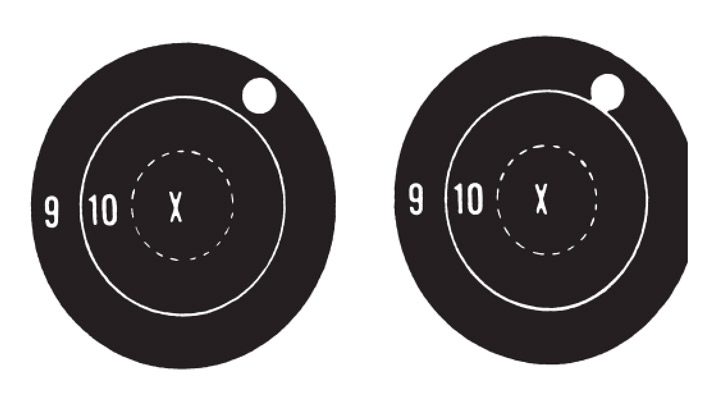
The basics of scoring a paper target are fairly straightforward. Similar to solving a puzzle, the goal for every scorer is to find where every shot fired went, and what value to assign them. Sounds easy enough, right?
The first thing to do is locate all the shots on the target and count them. For example, if there are 10 holes on a target after a 10-shot string, you are golden. Where it gets difficult is say, there are 12 shots on one target after 10-shot string. In a case like this there are extra holes, and as a scorer you have to figure out what happened. In general, careful examination the front and back of the target should help you spot the missing hole(s).

To aid in scoring targets, there are a plethora of gadgets available like scoring gauges (or plugs), magnifiers and overlays. The one used most often by far is the scoring gauge (also known as a plug), which has a pin the exact diameter of the bullet that goes into the shot hole. There should be at least one plug at any match recorded for classification. A plug should be inserted only once.
Below are a few helpful hints for scoring targets in three NRA disciplines—pistol, smallbore and high power rifle. While geared towards beginners, even advanced competitive shooters can benefit from a quick review.
Precision Pistol
In Precision Pistol, targets are scored after each 10-shot stage or five-shot string. Targets must be in good condition when they make it to the Statistical Office.
To determine the value of a shot hole, most of the time a visual inspection will suffice. However, shot holes where the leaded edge comes in contact with the bullseye or a scoring ring require the use of a scoring gauge. If the flange touches the scoring ring, the higher value is awarded. As for keyholes or tipped shots, the higher value is awarded if the bullet hole touches the scoring ring of higher value.
Smallbore Rifle
At an outdoor Smallbore Rifle match, targets are generally scored after every 20 shots. When scoring the target, any shots that are plugged should be marked. Any shot hole which touches the outside edge of the X-ring is counted as an X. In addition, scoring a Smallbore target may necessitate the use of multiple scoring gauges—inward and outward. For inward scoring, the higher value will be awarded if the gauge's flange touches the scoring ring. With an outward scoring gauge, all 10 dot shots (away from center) are gauged to determine the value of close shots with values of 10 to six.
If a group has three or more shots that may share an enlarged hole, shooters are generally given the benefit of the doubt and scored hits for the required number of shots in that bullseye.
High Power Rifle
Most of the time, High Power Rifle targets are scored in the pits. They may also be scored in the Statistical Office. Hits are scored based upon the diameter of the bullet. When the leading edge of a hole contacts the X-ring or other scoring rings, the higher value is awarded. For close shots, a scoring gauge or overlay can be used to determine the value. For the benefit of shooters, all close shots should be checked.
During slow fire, target pullers mark targets after each shot. They follow procedures outlined in the rues. After scoring is completed, scorers will enter the total score, sign the card along with the competitor, and deliver the scorecard to the Statistical Office.
For the most up to date news on NRA rules, subscribe to the Shooting Sports USA Insider newsletter.
See more: Accuracy Testing: Shortcomings Of The Five-Shot Group

































